A “user survey”, also sometimes known as a user experience survey or a “user testing survey”, can seem a little mysterious at first sight.
Now, we want to bring them closer to you by explaining:
- What user surveys are.
- interesting use cases for these types of surveys,
- the best practices when it comes to creating them.What type of user surveys you can create and for what purposes.
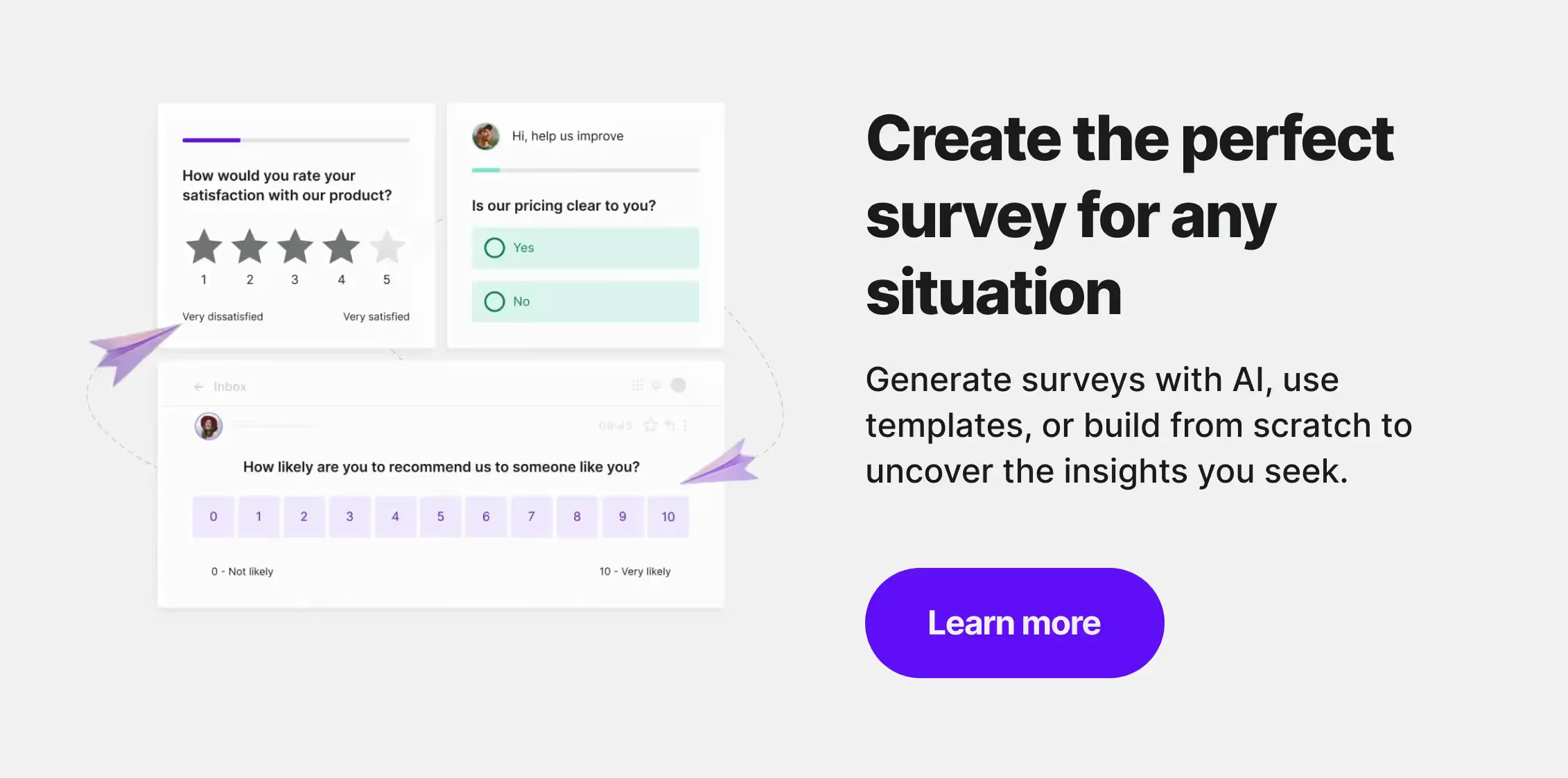
What is a user survey?
A user survey aims to improve your user or customer experience. You may conduct user surveys when you’re looking to improve a product, a strategy, or the overall performance of your business.
You'll find that most online user surveys are anonymous. However, there are some exceptions.
User surveys can collect either quantitative or qualitative data. Going further in this article, you’ll discover when to use what.
How to tackle user surveys in business – 6 use cases
The results of user surveys can provide your business with inspiration and knowledge you would not otherwise have.
#1 To understand your audience
In order to gain detailed customer experience feedback, you should do a few things–one of them is conducting customer satisfaction surveys.
Through the use of the right survey questions, you can discover details about your audience's needs and expectations.
They allow you to understand what your audience wants, requires, or lacks. In addition to providing you with the percentage information about overall customer satisfaction, user surveys can also show you areas that need improving based on open-ended questions, for example.
And more.
#2 To improve the quality of your services and products
Another case when you should also conduct user satisfaction surveys is when you want to improve the quality of your products or services and further boost customer satisfaction.
A user survey can then help answer questions such as:
- How do our customers feel about our product/service?
- What do our customers like the least about our product/service?
- What product features could we add to make our customer experience better?
- Is there anything we can do to increase sales?
- How could we go above and beyond when it comes to product management?
and many more. Insights gathered from user surveys can help you improve products more than you think. You simply only need to start conducting them.
#3 To enhance the customer experience
User surveys allow you to get to the root of a problem quickly by getting knowledge from the source - your customers.
In times when customer experience matters more than ever, it’s vital you take advantage of the solutions that are there.
In this case, though, it’s not only about how much customer feedback you gain, but how to act on it afterward. Running user surveys per se is great for the CX research stage, but only how you turn these insights into changes can help you ensure your brand has the best experience possible.
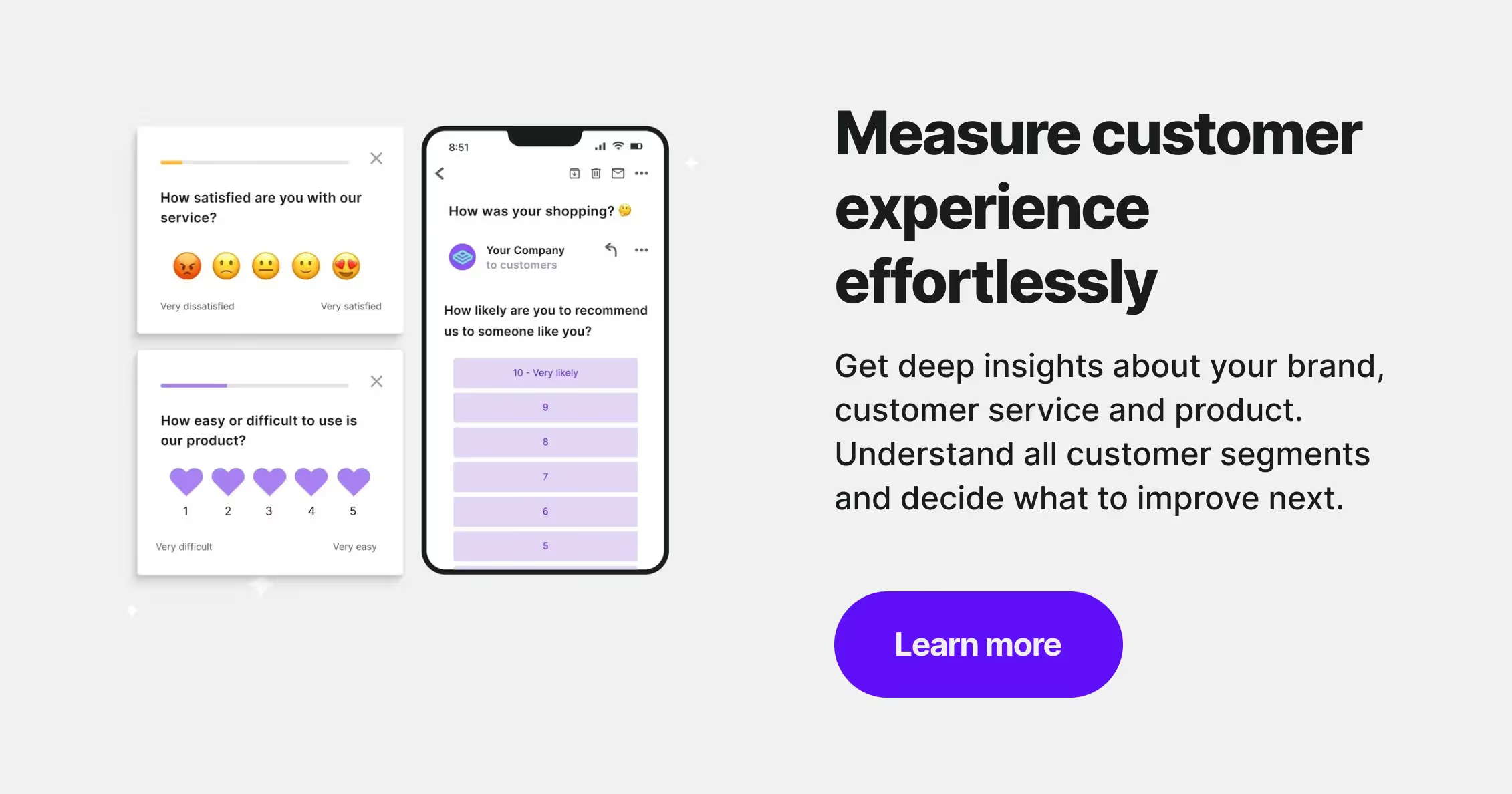
#4 To improve user onboarding
User onboarding is crucial for your product success, but the main problem with it is that you have no insights circulating around that you could use for improving this process.
Hence, your onboarding is awful.
Hence, you lose potential customers.
Hence, your business fails.
Again, user surveys are not a magic wand here.
💡 YOU MAY ALSO BE INTERESTED IN: Product copy clarity survey template
They can, though, deliver you insights to improve your product tours, discover new acquisition channels, and apply changes to each user touchpoint on your website or in your app. Even your sales demo can be revamped by them, and, in turn, finally, start to deliver.
Using a simple user persona survey, a customer onboarding survey, or even a quick NPS survey can give you actionable info for polishing the structure of user onboarding in your company.
Keep in mind that you shouldn’t overwhelm your customers with too many surveys all at once to avoid survey fatigue. Thus, use 1 or 2 of the examples given above – you’ll see it’s more than enough.
#5 To find brand ambassadors
Do you know that among your customers, you might have real gems who will promote your brand better than anything else?
These are called brand ambassadors.
Brand ambassadors are a powerful weapon of each brand and yours is lucky if you have even one of them. They spread a good word or two about your product, they naturally encourage others to try it out, and they will be the first in line to beta test new features or give you extensive feedback.
To identify them, you should look at your user surveys on two levels – who gave you the highest ratings, and who left some extensive feedback.
Then, you can get in touch with such people, get even more feedback, and get them on board as your ambassadors.
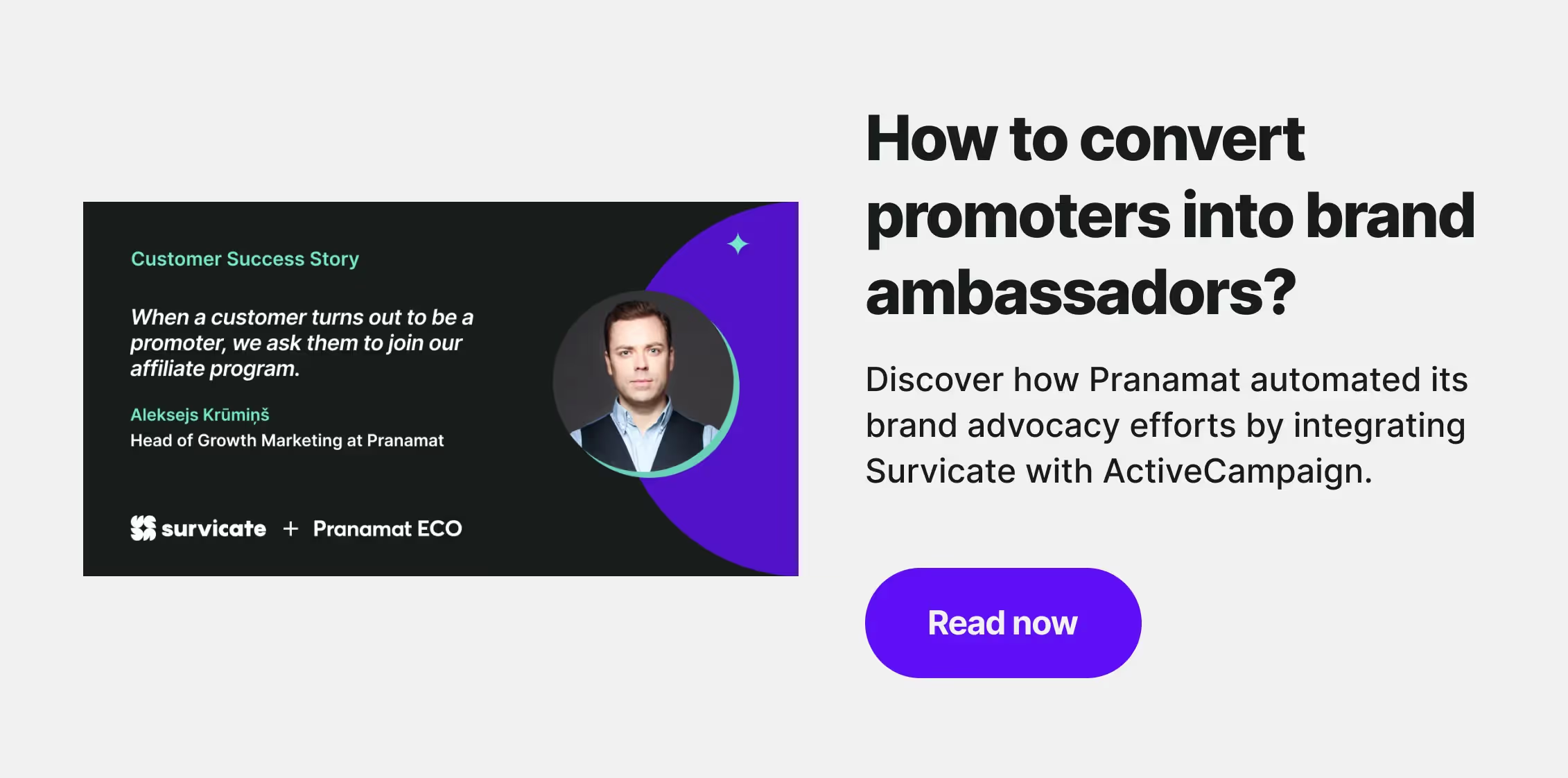
#6 To get content ideas
User surveys can turn out to be a goldmine for your content strategy. Asking why? Based on the answers and research, you can:
- identify the best performing channels and content formats
- modify your communication to deliver more valuable content
- create helpful articles and resources to solve pain points
- verify how successful – or not – your current strategy is
You might learn from your user surveys that users have a difficult time navigating through your platform. What to do with such a takeaway? While redesigning the platform might not be possible, you may want to create a couple of new articles, manuals, or tutorials, and add them to your knowledge base – all based on a few insights from the surveys.
And that’s just one of the examples. Taking it even further, you can conduct content rating surveys regularly. Place them at the end of your articles for example and see the feedback flowing – it's a great way to see where you stand, or should stand, with your content.
5 user surveys best practices
You run user surveys not to get any feedback, or no feedback – you do it to get valuable and actionable feedback that will move the needle. Below are a few tips to help you create a successful user survey.
#1 Use plain language
The language of your surveys HAS TO BE clear for potential respondents. If you over-complicate your surveys, your respondents may not finish the whole survey, or unconsciously give false answers. Such a scenario can significantly impact your survey results in a rather negative way.
To avoid this, be sure that you use easy-to-understand language when writing survey questions. If you want to add open-ended questions, double-check if they are easy not only to answer but also to interpret. For example, if you ask:
What do you think about our new product?
Specify which product you have in mind – otherwise, the inputs may not give you the answer you’re looking for, as people will refer to what’s new for them. If you’re surveying users in various languages, you may also consider translating and localizing your surveys for them so that they can fully understand everything.
Examples? Well, sending a “How helpful is our call center?” survey surely is a great idea – but you may be surprised how many more answers you’ll get if you change “center” to “centre” when sending it to your British audience.
(side note: If you want to ask “What do you enjoy doing now when the summer is in full swing?”, check if your group is actually enjoying summer right now. Quite unlikely if they are in another hemisphere, isn’t it?)
✅ use simple words and phrases
✅ ask straightforward open-ended questions
✅ translate and localize survey questions when applicable
⛔ don’t use complicated jargon and confusing terms
⛔ don’t use leading questions
#2 Balance the length
Everything in life is about balance – so is adjusting the length of your user surveys. To ensure that your user feedback surveys are fully answered, you should make them short. No one will want to complete surveys that are 50 questions long. And here, the numbers speak for themselves:
According to our research, some of the surveys reaching really high completion rates (above 50%) consist of fewer than 15 questions per survey.
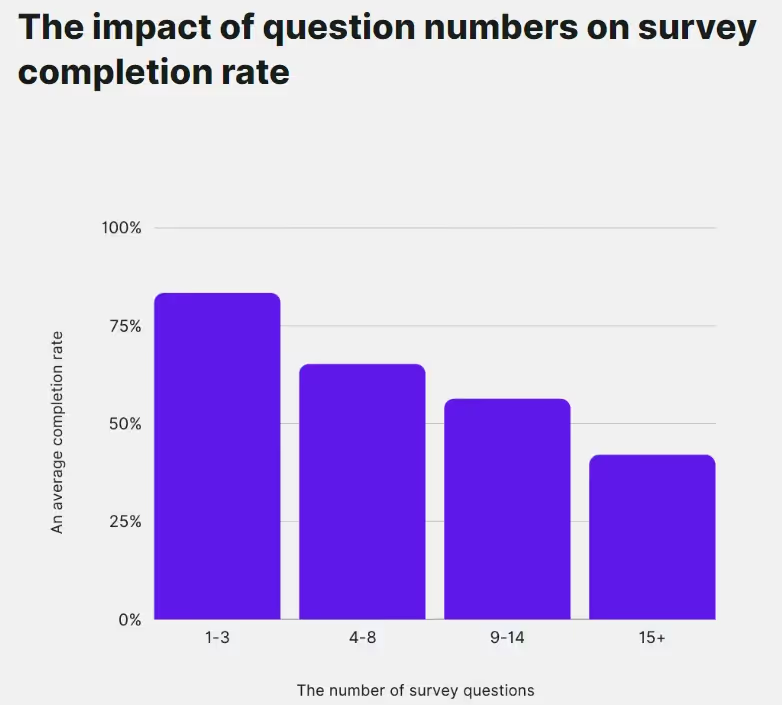
If that data is not enough, we have more up our sleeves:
- Surveys that included 1-3 survey questions had an average completion rate of 83.34%.
- Surveys with 15 questions and more have a completion rate of 41.94%.
- Questionnaires with 9-14 questions have a completion rate of 56.28%.
- The average completion rate drops to 65.15% in 4-8 questions surveys.
This only proves that less is more. Take into consideration that some people may need to take your surveys when commuting, during their working break, on mobile devices, or in a drastic rush. The shorter and more to-the-point you make your user survey for them, the more answers you can get.
It doesn’t mean that you need to shorten your survey from 30 to 3 questions (or maybe, why not?) – but rather classify them, check whether you can merge some of them, and evaluate if you need them at all. You can always include some optional open-ended questions for those who want to share their feedback, but don’t make them obligatory to complete the survey.
✅ think your questions through in advance
✅ beta-test your surveys with a few people before it’s launched
⛔ don’t make your surveys excessively long
⛔ eliminate questions that don’t bring much impact
#3 Encourage participation with incentives
Which of the following statements would you find more appealing?
- Hi, please fill in my survey, cheers.
- Hello! I’m running a survey on XYZ and would love to hear your thoughts. Three lucky respondents will receive a free upgrade with addons for 3 months!
I can only bet you’re up for that free upgrade grabs. Even though some people are willing to take surveys without incentives, offering a small reward will often increase both participation and completion.It is also a way to appreciate your respondents' time and effort. Business owners tend to avoid giving incentives because they believe such activities must cost a lot of money. It's wrong thinking. Here are just a few examples of incentives you can give:
- monetary: cash, vouchers, gift cards, tickets
- non-monetary (within the product): beta access, discounts, bonus points, upgrades, ebooks
✅ offer discount codes, and freebies in exchange for participation
✅ find out what incentives will be most attractive
⛔ don’t assume people will just take your surveys - time is money!
⛔ don’t stay away from survey incentives, especially if you struggle to get your completion rate right
#4 Make surveys user-friendly
Your user surveys, as the name indicates, are about your users. And their time. This is why you should make sure each user survey is user-friendly. While length or incentives are important to bring you closer to success, there are other factors to take into consideration. One of them can be a channel you use for sending your surveys through. Sending surveys via email, according to our report, can land you an average completion rate of 74%. You can do more than that – test out how to boost it even further.
Survey Practice research shows that embedding the first question directly into your email encourages more survey responses:
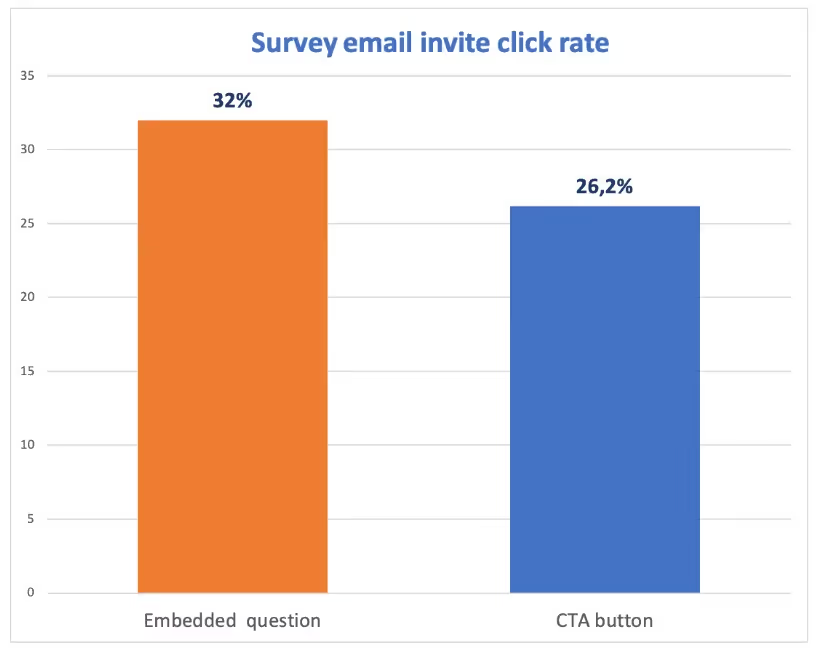
To make your survey as user-friendly as it could be, you need a few things – good research, a set of right questions, an analysis of channel distribution, and a tool to help you turn all that info into an actionable asset. We are able to assist with the last step, at the very least. With Survicate, you can set up various types of surveys in just a few minutes.

✅ pay attention to what question types bring the best results
✅ use survey tools such as Survicate for user-friendly surveys
⛔ don’t send surveys you haven’t tested out for user experience
⛔ don’t stick to just one type of survey – A/B testing exists for a reason
#5 Learn from past surveys
There’s nothing better you can do than learning from your previous experiences – if you already have them. You might not learn what to do, but you definitely learn what not to do. Data is not for framing into a picture or for gathering dust on a hard drive, but for analyzing and acting upon.
You need to know answers to questions like:
- What question types performed the best?
- In my best-performing surveys, how many questions did I usually ask?
- When it comes to the survey types, which one performed the best in the past?
- What was the distribution method for my best-performing surveys?
- What time were my best-performing surveys sent to my respondents?
We get it – acting on data, getting all these insights, and drawing conclusions is just tiresome. You’re not alone on that journey, though. No matter if you already started with user surveys, or looking for implementing them, make sure you have a survey tool in your arsenal that delivers:
- dashboards,
- filtering,
- respondent-level analytics,
- data export,
- reports and alerts,
- survey statistics and folders,
to give you a few examples. Survicate ticks all of these boxes.
.avif)
✅ analyze your past surveys’ results
✅ take advantage of survey software with helpful analytics features
⛔ don’t neglect the importance of analyzing your surveys’ performance
⛔ don't get buried under piles of analytics without a conclusion :-)
Types of user surveys you can create
You’ve decided – user surveys are the way to go. Well done! But…
Do you need help choosing the right type of user survey for your needs, but aren't sure what to use?
There are a few types that you can choose from.
#1 CSAT - Customer Satisfaction Score Survey
CSAT stands for Customer Satisfaction Score. This measure lets you know how happy your customers are with a recent experience they had with your brand. By calculating customer satisfaction, you can predict customer loyalty and identify weak points in your customer service program, or product development. How CSAT is calculated? Divide the total number of satisfied customers by the total number of respondents and then multiply by 100 to get your final result.

Use CSAT surveys when:
- you want to understand your customer loyalty and focus on measuring customer satisfaction throughout the customer journey
- you would like to know what percentage of satisfied customers you have at your service (and compare it with your competitors)
- you need to assess the popularity of a new product, feature, or webinar, so you want to know how users feel about it
- you want to understand what can be improved in your business and what you have already succeeded at
There are so many questions that customer satisfaction surveys can answer that you'll only be asking yourself one: Why am I only doing it now? Example of a CSAT survey question (that you can set up in seconds in Survicate, btw)
#2 NPS - Net Promoter Score Survey
NPS stands for Net Promoter Score and it’s another popular customer satisfaction metric. It measures clients’ sentiment towards the brand based on the answers to one question. A good example of a question is: “How likely are you to recommend [company name] to a friend or colleague?”, but you can see variations such as “How well do our services meet your needs?”.
How NPS is calculated:

It allows you to see how recommendable your business is from a customer's perspective, in principle. The NPS score is calculated by combining the answers you got in the NPS survey, and subtracting the detractors from the promoters. Your NPS would be 50 (70-20) if 70% of respondents are promoters, 20% are detractors, and 10% are passives. As a business, you naturally want to get only 9s and 10s from your promoters – those who would be willing to recommend your business further.
To cheer you up though – even the most loved companies in the world have many, many, many detractors.
BY THE WAY - FEEL FREE TO USE OUR FREE NPS CALCULATOR
#3 CES - Customer Effort Score Survey
The Customer Effort Score measures… an effort. The effort that your customers make in interacting with your business – how seamless or troublesome it was for them. CES was developed by Gartner in 2010. According to their research, customers with a good CES are more likely to repurchase or extend their subscription.
How CES is calculated:

Essentially, a CES survey asks customers whether an interaction like:
- experimenting with a new feature,
- buying a product, service, or subscription,
- contacting a support team, or
- reading a help center article,
was a high- or low-effort experience.
If it turns out that interacting with your customer service team was extremely difficult, you need to take action. Running an internal audit, automating self-service, hiring more people, or streamlining current processes are just a few actions you can take.
#4 PMF - Product-Market Fit Survey
Using a product-market fit survey, you can ask your customers about their experiences with – or actually, without – your product.
You may think, though: What is the point of asking your customers how they might feel without your product?
Let’s say you send the above survey to 100 users from your database, and 88% of them answer that they would not be disappointed at all if you decide to e.g. discontinue the product. This gives you a lot of food for thought, from smaller things like changing the pricing through product development and adding new features, to, actually, deciding whether it makes any business sense to keep the product afloat. It can be brutally honest, but you may really appreciate it.
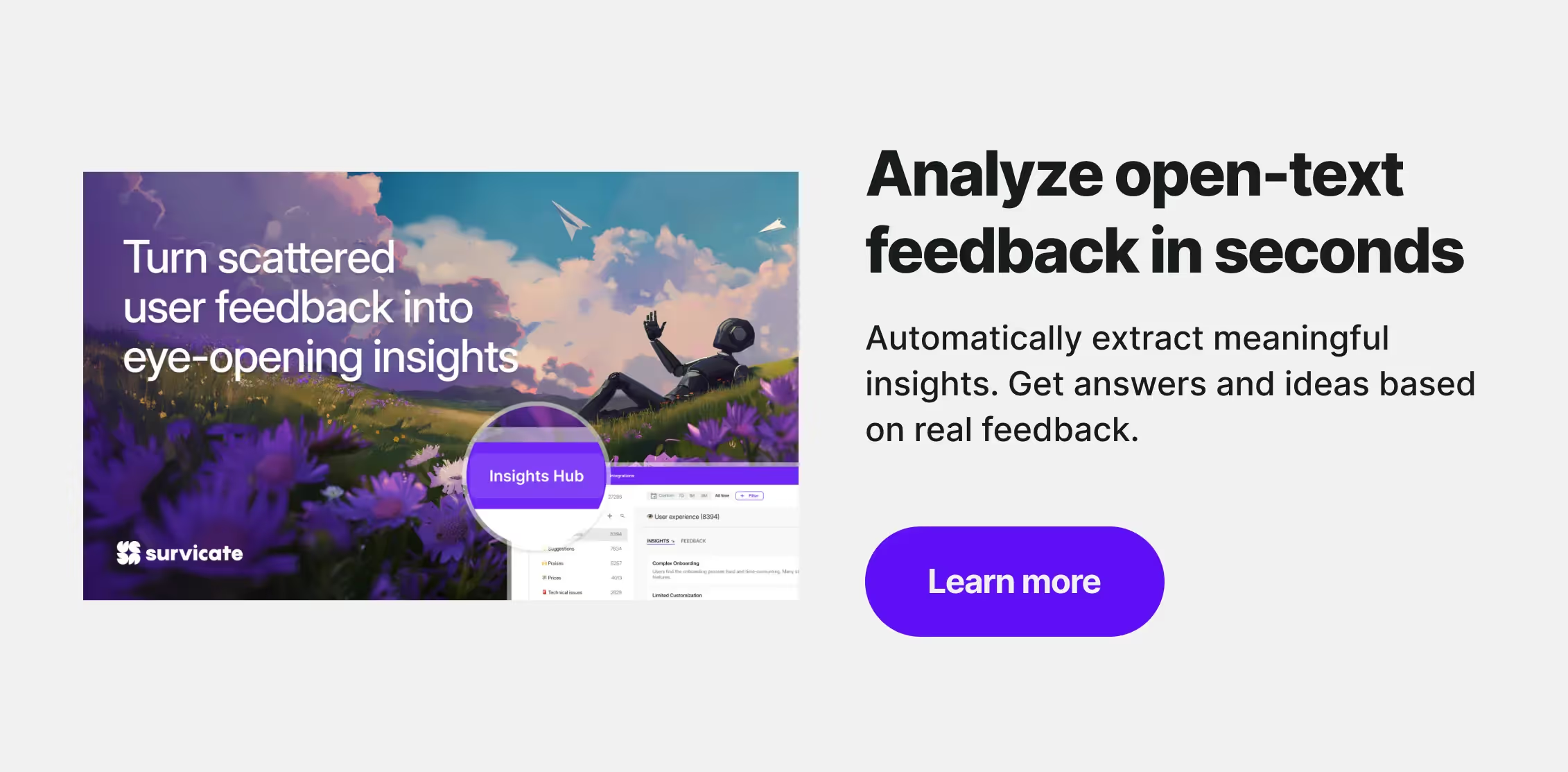
User Surveys - Collecting User Feedback Made Easy
Not leveraging user surveys in your strategy is like watching a foreign movie with subtitles. You may guess or see a thing or two from what you see or hear, but you won’t understand everything, won’t get a full picture, and you’re very susceptible to missing crucial plot points. From understanding your audience, through getting content ideas, all the way up to improving customer experience and your product - user surveys are simply there to make sure your efforts don’t go unnoticed. However, conducting surveys won't be effective without the right preparation.
The right research, the right questions, the right timing – and the right tool to top it up. With survey software tools like Survicate, sending user surveys stops being a sad to-do list element – it becomes an exciting and easy-to-leverage activity. Doubts? Sign up for your 10-day free trial today and see for yourself. Also, you can foster your decision-making by checking our newest ranking of best customer satisfaction tools.








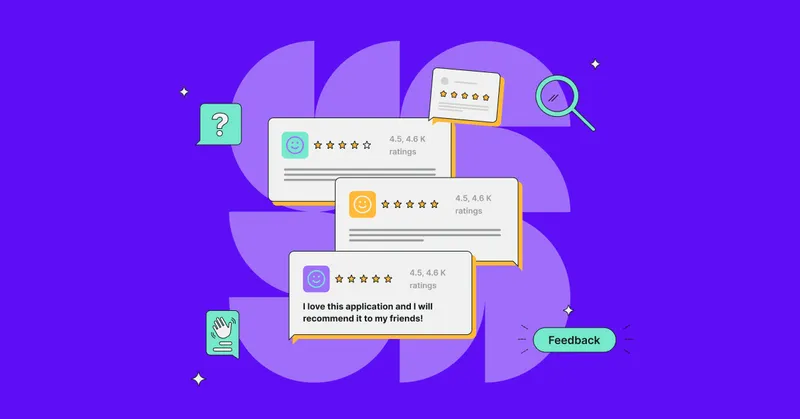
.webp)
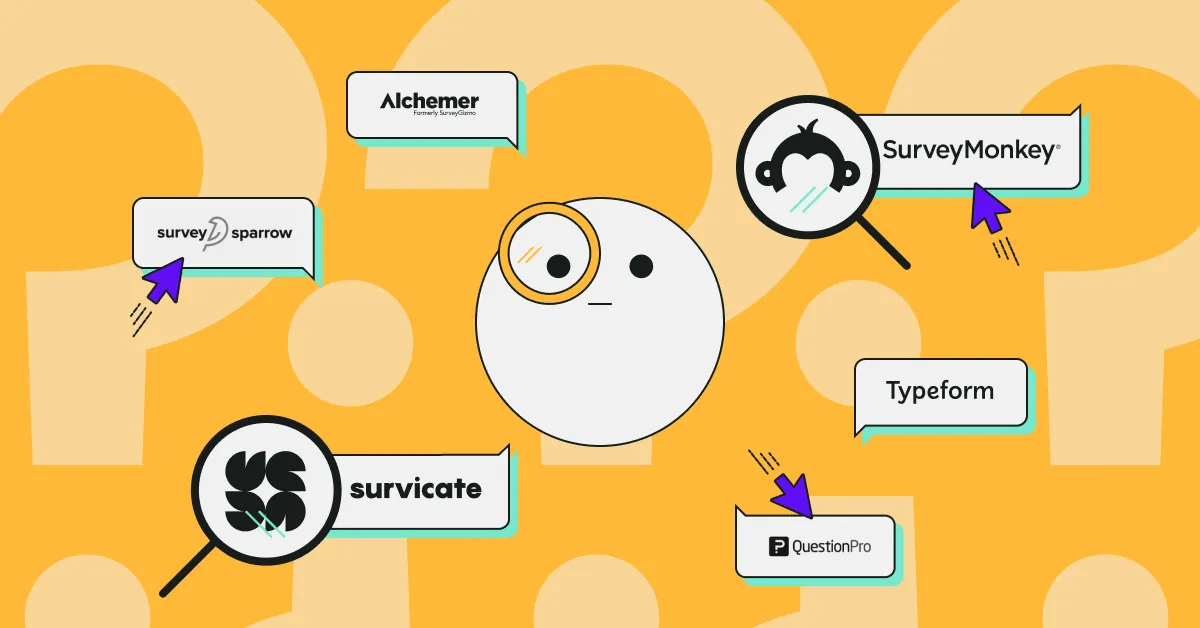
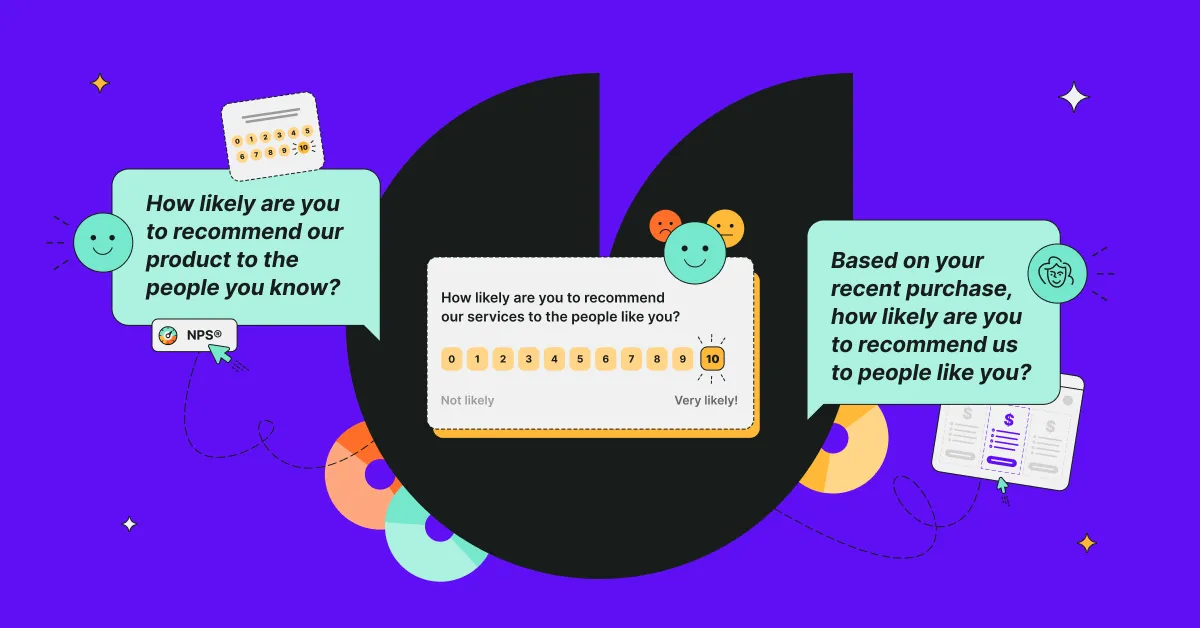
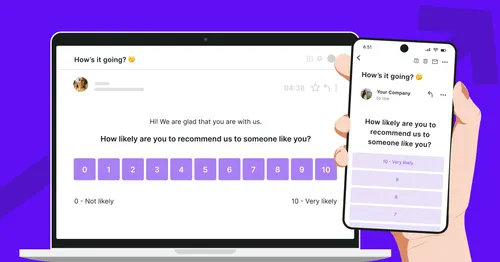
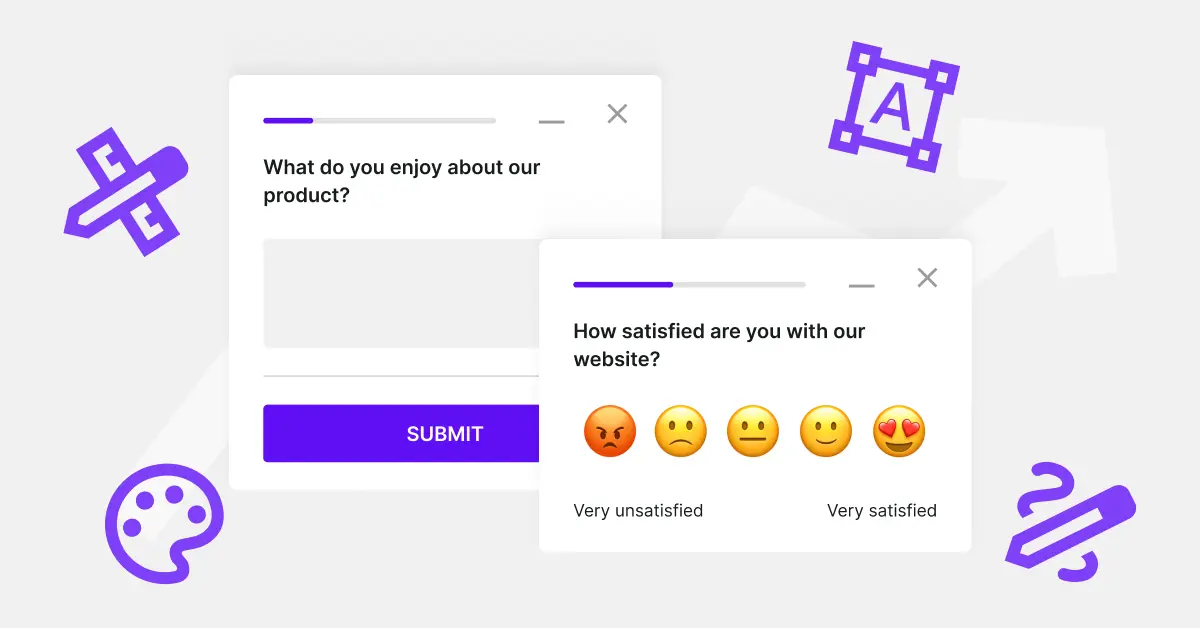
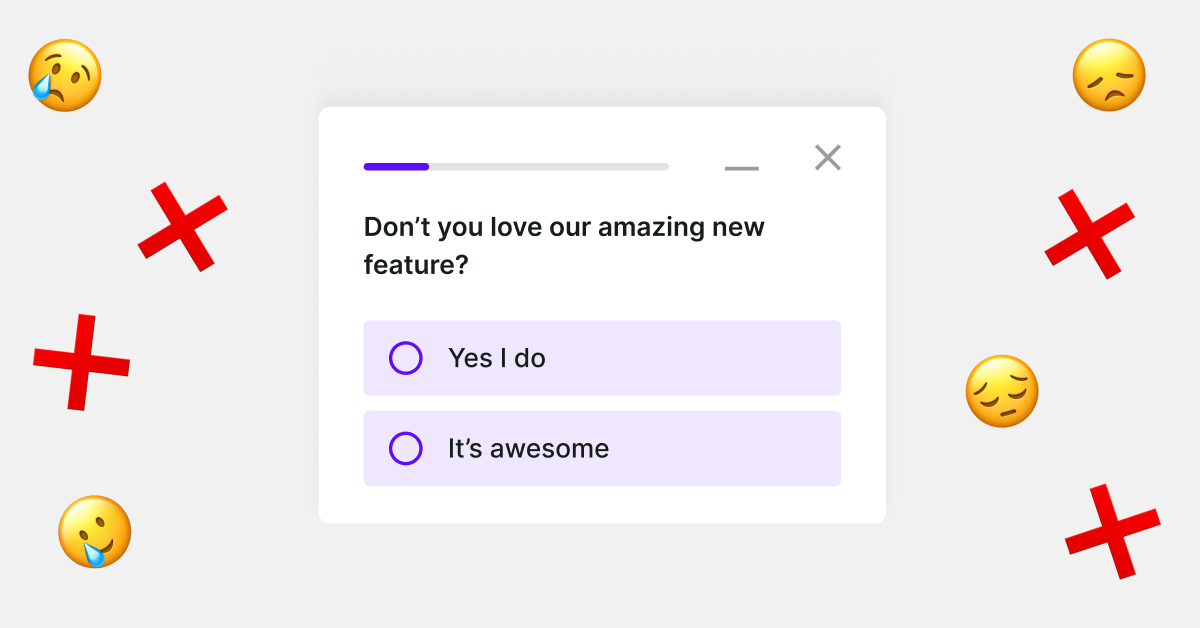
.svg)

.svg)



